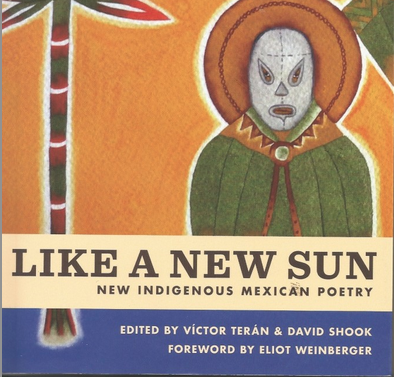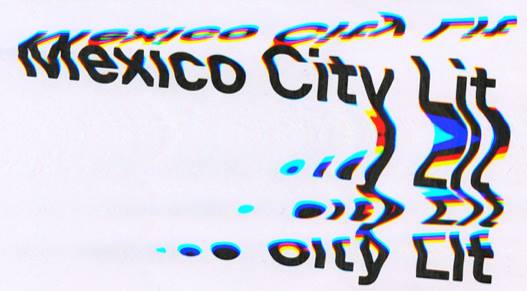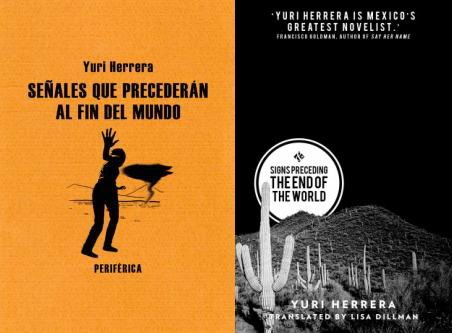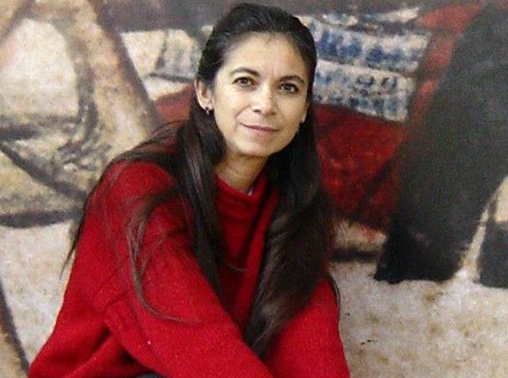Happy Friday, Asymptote pals! Have you had a chance to check out Asymptote‘s year-end fundraiser yet? Our fifth(!) anniversary is just around the corner, and we’ve got fifteen events planned in cities all around the world to celebrate—but we need your help. Take a look at this year’s end-of-year Indiegogo, with all its tantalizing prizes (postcards! bookmarks! anniversary tickets—of the Asymptote sort), and remember the greatest gift is knowing you’re part of an organization doing seriously good work for world literature. READ MORE…
Posts filed under 'Mexico'
Weekly News Roundup, 11 December 2015: Gift’s No Poison

This week's top literary links from all around the world
Translating Indigenous Mexican Writers: An Interview with Translator David Shook

"I suspect many casual bookstore readers might not know how many languages are still spoken in Mexico. The sheer diversity is astounding."
David Shook is a poet, translator, and filmmaker in Los Angeles, where he serves as Editorial Director of Phoneme Media, a non-profit publishing house that exclusively publishes literature in translation. Their newest book is Like a New Sun, a collection of contemporary indigenous Mexican poetry, which Shook co-edited along with Víctor Terán.
Seven translators in total—Shook, Adam W. Coon, Jonathan Harrington, Jerome Rothenberg, Clare Sullivan, Jacob Surpin, and Eliot Weinberger—translated poets from six different languages: Juan Gregorio Regino (from the Mazatec), Mikeas Sánchez (Zoque), Juan Hernández Ramírez (Huasteca Nahuatl), Enriqueta Lunez (Tsotsil), Víctor Terán (Isthmus Zapotec), and Briceida Cuevas Cob (Yucatec Maya). I corresponded with Shook over gchat to speak with him about the project.
***
Today is Columbus Day, a controversial holiday in the United States. Several cities have recently adopted Indigenous Peoples’ Day over Columbus Day, clearly a victory for recognizing indigenous cultures in the United States. Which leaves me wondering: how are the indigenous Mexican writers recognized today in the Mexican literary landscape?
As someone who regularly visits Mexican literary festivals and also translates from the Spanish, I’ve observed the under-appreciation of indigenous writers firsthand. Mexico’s indigenous communities make up 10 to 14% of its total population, and you certainly don’t find anywhere near that percentage of literature being published in Mexico today. READ MORE…
Translation Tuesday: “Amigos Mexicanos” by Juan Villoro

I was afraid he was going to ask me to give him back the money (...) I told him I was busy because a witch had put the evil eye on me.
1. Katzenberg
The phone rang twenty times. The caller must have been thinking that I live in a villa where it takes forever to get from the stables to the phone, or that there’s no such thing as cordless phones here, or that I experience fits of mystic uncertainty and have a hard time deciding to pick up the receiver. That last one was true, I’m sorry to say.
It was Samuel Katzenberg. He had come back to Mexico to do a story on violence. Last visit, he’d been traveling on The New Yorker’s dime. Now he was working for Point Blank, one of those publications that perfume their ads and print how-to’s on being a man of the world. It took him two minutes to tell me the move was an improvement.
“In Spanish, point blank is ‘a quemarropa.’” Katzenberg hadn’t grown tired of showing off how well he spoke the language. “The magazine doesn’t just publish fluff pieces; my editor looks for serious stories. She’s a very cool mujer, a one-woman fiesta. Mexico is magical, but confusing. I need your help to figure out which parts are horrible and which parts are Buñuel-esque.” He tongued the ñ as if he were sucking on a silver bullet and offered me a thousand dollars.
Then I explained why I was offended.
Mexico City Lit on Radical Translation: Part I

"Translation is the adjustment of voltage and signal within a language system. But every adjustment is an ideological statement."
Every readable sentence carries a subliminal thrum of voltage. Language is the total circuitry of power relations that take place within the groups deploying that language. If translation means the movement between languages, then the act of translation is in some sense a rerouting of that linguistic voltage.
To paraphrase David Bellos, however: an “asymmetrical relationship” is involved in any translation act. Upward translation moves from a less prestigious or powerful language to one considered “stronger.” Almost all translations into English, for example, can be conceived of as “upward translations “ Translation-downwards, therefore, implies movement from a stronger language to one with a smaller readership, or which possesses less cultural and economic prestige.
Have you ever noticed how “un-Japanese” Haruki Murakami feels in English translation, compared to other Japanese writers? Part of this is his own writerly project, born as it is out of an admiration for the likes of Raymond Chandler and J.D. Salinger. But where his translations are concerned, it feels as though twists which may have caused his foreign-language audience to read twice have been effaced or unkinked in the English. READ MORE…
In Review: “Signs Preceding the End of the World” by Yuri Herrera

Ethan Perets reads a new novel sure to be considered "an enduring document of world literature."
What kind of journey begins without the possibility or intention of return? And what kind of person sets out, all the while knowing this to be the case?
Tales of the epic quest often take such questions as starting points. But the latest novel from contemporary Mexican writer Yuri Herrera, titled Signs Preceding the End of the World, rejects each of these questions from the outset.
Recently translated into English by Lisa Dillman for And Other Stories, Signs Preceding the End of the World focuses on Makina, a young Mexican woman, as she travels from her rural village across alien towns, ice-green rivers and black mountain passes searching for her brother north of the U.S.-Mexico border. Equipped with the determination to return home after a short trek across the border, she leaves with few provisions, which include, among other things, “one white blouse and one with colorful embroidery, in case she came across any parties.”
As Makina meets up with the “top dogs” in her town who arrange for her trip, Herrera offers a glimpse of the men that loom behind Mexican organised crime: Mr. Double-U, “a joyful sight to see,” the hustling Mr. Aitch, who hangs with his gang of misfits at the literarily-named drinking establishment Pulquería Raskolnikova, and the tight-lipped Mr. Q, who “never resorted to violence—at least there was nobody who’d say he did.” Besides adding a touch of Tarantino-esque flair to these shady characters, Herrera essentially establishes a novel of personalities. Biggest among them is Makina herself. READ MORE…
Octavio Paz New York Centennial: Perpetually Creating Rhythm

A dispatch honoring one of Mexico's most celebrated poets
From October 1st to the 8th, the Mexican Cultural Institute of New York paid tribute to the centennial of Octavio Paz’s birth with a series of discussions, readings, concerts, and film screenings. A prolific poet, essayist, intellectual, translator, editor, publisher, and diplomat, Paz published his first poetry collection, Luna Silvestre (Wild Moon, 1933) at 19 years old, penning over 26 volumes of poetry until his death in 1998. Paz was also an accomplished essayist: his 1950 treatise on Mexican identity, El laberinto de la soledad (The Labyrinth of Solitude) is considered a seminal work of literature. The recipient of the Cervantes award in 1981, the American Neustadt Prize in 1982, and the Nobel Prize in Literature in 1990, Paz founded three literary magazines, Taller, Plural, and Vuelta; Vuelta is still published as Letras Libres.
Now that we’ve gotten that dry but necessary introduction out of the way, let me truly begin.
The centennial celebration was a sumptuous banquet I wanted to gorge myself on until I developed gout, like those rich men of old. I eagerly chased Paz throughout New York City, from the second-floor gallery of the Mexican Consulate in Midtown to the ornate ballroom of the Americas Society in the Upper East Side, and finally to where the river meets the city, the “navel of the poetic universe,” as Paz’s translator Eliot Weinberger playfully referred to the Poets House in TriBeCa.
Translation Tuesday: “The Jails Take to the Streets” by Carmen Boullosa

Fresh fiction by Mexican writer Carmen Boullosa, translated by Kristina Zdravič Reardon
Featuring a kidnapping, a prison, a drug lord, an inmate called the Inmate-Prince, and a prostitution network, Carmen Boullosa suggests through stark satire in this story that truth is, indeed, stranger—and more complex—than fiction. At the same time, she addresses the narrative gaps between truth and fiction head-on with four levels of meta-narrative.
To begin, she writes that this piece is “a conversation between a film producer (John Grandcaca), a multi-award-winning Mexican writer (Julio de la X), and the assistant producer, with a moralizing note from the author.” At once, we see four levels of narration: the writer’s script, the summary of the script from the assistant producer, the commentary on the summary of the script from the producer to the writer, and the commentary from the fictional stand-in for Boullosa. Yet the narrative proves even wilder than the layers might at first suggest.
Mexico released official crime rate statistics from the last several years this spring. While some claim the statistics are dubious, the publication highlights a high number of kidnappings, extortions, and thefts across the country. Boullosa draws attention to these through dark humor here, and in doing so, forces the reader to reflect on the gaps between truth and fiction and how we, as readers, navigate that divide.
—Kristina Zdravič Reardon
Translation Tuesday: “The Imaginary Pet,” “On Dragons”

Surreal tales from Mexican author Cecilia Eudave, translated by criticism editor Ellen Jones
The Imaginary Pet
As I was drinking my tea and noting the unique colour of the jacaranda tree, I was struck suddenly by a sad, painful memory: my first pet. She wasn’t cruel or aggressive, quite the opposite, she was a sweet creature, delicate and extremely intelligent (she taught me to read), with a slender body the colour of a jacaranda, so skinny she could have passed for a bookmark. She was my best friend, she went with me everywhere, slept in my bed, came out with me in my bag, played games with me, sang me to sleep. She always kept watch over my dreams, and with her by my side no nightmare ever dared enter my head.
